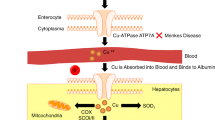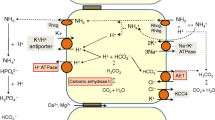Summary
The Dacus oleae larva possesses four Malpighian tubules, two anterior and two posterior ones, which in pairs enter into a ureter. Before opening into the gut, at the level of the transition zone between the mid- and hindgut, each ureter is dilated into an ampulla.
The anterior tubules are divided into four regions: distal, transition, middle and proximal ones: while in the posterior tubules only middle and proximal segments are detectable. The distribution of the enzyme systems is indicated in Fig. 3, while the ultrastructural organization which is typical of the cells composing the different regions is schematically represented in Fig. 1. According to the ultrastructural and enzymatic findings, and the discussion on this subject in the literature, the authors are led to assume that in the distal segment occurs the segregation of uric acid, urates and calcium salts. In the transition segment, and still more in the intermediate one, an indiscriminate transport of water and solutes occurs from the haemocoel into the lumen of the tubule by pinocytosis. A fraction of the catabolites is precipitated as chromolipoidal pigments. The transition stages between cytosomes and pigment are described. Along with secretory phenomena the resorption of useful substances occurs in the proximal region. A similar function is performed by the ureter. In the ampulla, which is characterized by a conspicuous system of deep tubular infoldings both at the apical and basal surfaces of its cells, a massive water resorption is presumed to occur.
Similar content being viewed by others
Bibliografia
Ashford, T. P., and K. R. Pouter: Cytoplasmic components in hepatic cell lysosomes. J. Cell Biol. 12, 198–202 (1962).
Baccetti, B.: Ricerche sull'ultrastruttura dell'intestino degli insetti. II. La cellula epiteliale del mesentero in un Ortottero, un Coleottero e un Dittero adulti. Redia 46, 157–165 (1961 a).
—: I tubi malpighiani della femmina adulta dei Diaspini (Hemiptera, Omoptera, Coccoidea). Verh. XI. Int. Ent. Kongr. Wien, 1960, Bd. I, S. 752–758 (1961 b).
—: Ricerche sull'ultrastruttura dell'intestino degli Insetti. IV. Le papille rettali in un Ortottero adulto. Redia 47, 105–118 (1962).
Beams, H. W., T. N. Tahmisian and R. L. Devine: Electron microscope studies of the malpighian tubules of the Grasshopper Melanoplus differentialis (Orthoptera Acrididae). J. biophys. biochem. Cytol. 1, 197–202 (1955).
Berkaloff, A.: Contribution a l'étude des tubes de Malpighi et de l'excrétion chez les insectes. Ann. des Sci. natur. Zool., Ser. XII, 869–947 (1960).
Bradfield, J. R.: New features of protoplasmic structure observed in recent electron microscope studies. Quart. J. micr. Sci. 94, 351–367 (1953).
Chauvin, R.: Physiologie de l'insecte. Publ. I.N.R.A., Paris 1956.
Craig, R.: The physiology of excretion in the insect. Ann. Rev. Ent. 5, 53–68 (1960).
Daems, W. Th., and Th. G. Van Rijssel: The fine structure of the peribiliary dense bodies in mouse liver tissue. J. Ultrastruct. Res. 5, 263–290 (1961).
Day, M. F.: The distribution of alkaline phosphatase in insects. Aust. J. Sci. Res. B 2, 31–41 (1949).
—, and M. Briggs: The origin and structure of bronchosomes. J. Ultrastruct. Res. 2, 239–244 (1958).
Essner, E., and A. B. Novikoff: Human hepatocellular pigments and lysosomes. J. Ultrastruct. Res. 3, 374–391 (1960).
—: Localization of acid phosphatase activity in hepatic lysosomes by means of electron microscopy. J. biophys. biochem. Cytol. 9, 773–784 (1961).
Hudson, G., and J. F. Hartmann: The relationship between dense bodies and mitochondria in motor neurones. Z. Zellforsch. 54, 147–157 (1961).
Lison, L.: Etudes histophysiologiques sur le tube de Malpighi des insectes. II. Phénomènes d'athrocytose dans le tube de Malpighi chez les orthoptères. Arch. Biol. (Liège) 48, 489–512 (1937).
Martoja, A.: Données cytologiques et histochimiques sur les tubes de Malpighi et leurs sécrétions muqueuses, chez Locusta migratoria R. et F. (Orthoptère, Acridien). Acta histochem. (Jena) 6, 185–217 (1959).
Mazzi, V., e B. Baccetti: I tubi malpighiani e la secrezione della seta nelle larve di Donus crinitus Boheman. Redia 41, 315–341 (1956).
—: Fosfatasi alcalina e fosfatasi acida nei tubi malpighiani degli Hyperini durante la secrezione della seta. Redia 42, 277–282 (1957a).
—: Prime ricerche istochimiche comparative sui tubi malpighiani degli insetti. Redia 42, 383–392 (1957b).
— e G. Massimello: Localizzazioni enzimatiche nei tubi malpighiani della larva di Dacus oleae Gmel. Redia 47, 99–103 (1962).
Meyer, G. F.: Elektronenmikroskopische Untersuchungen an den Malpighi-Gefäßen verschiedener Insekten. Z. Zellforsch. 47, 18–28 (1957).
Merriam, R. W.: On the fine structure and composition of the nuclear envelope. J. biophys. biochem. Cytol. 11, 559–570 (1961).
—: Some dynamics aspects of the nuclear envelope. J. Cell. Biol. 12, 79–90 (1962).
Novikoff, A. B.: Lysosomes and related particles. In: J. Brachet and A. E. Mirsky (Eds.), The cell. vol. II, pp. 423–188. New York: Academic Press 1961.
Palay, S. L., and L. J. Karlin: An electron microscopic study of the intestinal villus. II. The pathway of fat absorption. J. biophys. biochem. Cytol. 5, 573–584 (1959).
Patton, R. L.: Excretion. In: K. D. Roeder (Ed.), Insect physiology, p. 386–403. New York: J. Wiley & Sons 1953.
Pease, D. C.: Electron microscopy of the tubular cells of the kidney cortex. Anat. Rec. 121, 723–744 (1955).
Ramsay, J. A.: Active transport of potassium by the Malpighi tubules of insects. J. exp. Biol. 30, 358–369 (1953).
—: Active transport of water by the Malpighian tubules of the stick insect, Dixippus morosus (Orthoptera, Phasmidae). J. exp. Biol. 31, 104–113 (1954).
—: The excretory system of the stick insect (Dixippus morosus) (Orthoptera, Phasmidae). J. exp. Biol. 32, 183–199 (1955a).
—: The excretion of sodium, potassium and water by the Malpighian tubules of the stick insect, Dixippus morosus (Orthoptera, Phasmidae). J. exp. Biol. 32, 200–216 (1955b).
—: Excretion by the Malpighian tubules of the stick insect, Dixippus morosus (Orthoptera, Phasmidae): calcium, magnesium, chloride, phosphatase and hydrogen ions. J. exp. Biol. 33, 697–708 (1956).
—: Excretion by the Malpighian tubules of the stick insect, Dixippus morosus (Orthoptera, Phasmidae): amino acids, sugars and urea. J. exp. Biol. 35, 871–891 (1958).
Rhodin, J.: Anatomy of kidney tubules. Int. Rev. Cytol. 7, 485–534 (1958).
Smith, D. S., and V. C. Littau: Cellular specialization in the excretory epithelia of an insect, Macrosteles fascifrons Stal (Homoptera). J. biophys. biochem. Cytol. 8, 103–133 (1960).
Tsubo, I., and P. W. Brandt: An electron microscopic study of the malpighian tubules of the grasshopper, Dissosteira Carolina. J. Ultrastruct. Res. 6, 28–35 (1962).
Tuppy, B. F.: An electron microscope study of the uptake, transport, and storage of colloidal materials by the cells of the vertebrate nephron. J. Ultrastruct. Res. 5, 291–310 (1961).
Waterhouse, D. F.: Studies of the physiology and toxicology of blowflies. XIV. The composition, formation, and fate of the granules in the malpighian tubules of Lucilia cuprina larvae. Aust. J. Sci. Res. B 3, 76–112 (1950).
Wigglesworth, V. B.: The physiology of excretion in a blood-sucking insect, Rhodnius prolixus. I. Composition of the urine. J. exp. Biol. 8, 411–427 (1931 a).
—: The physiology of excretion in a blood-sucking insect, Rhodnius prolixus. II. Anatomy and histology of the excretory system. J. exp. Biol. 8, 428–442 (1931 b).
—: The physiology of excretion in a blood-sucking insect, Rhodnius prolixus. III. The mechanism of uric acid excretion. J. exp. Biol. 8, 443–451 (1931 c).
Author information
Authors and Affiliations
Rights and permissions
About this article
Cite this article
Mazzi, V., Baccetti, B. Ricerche istochimiche e al micro scopio elettronico sui tubi malpighiani di Dacus oleae Gmel.. Z. Zellforsch. 59, 47–70 (1963). https://doi.org/10.1007/BF00321007
Received:
Issue Date:
DOI: https://doi.org/10.1007/BF00321007




